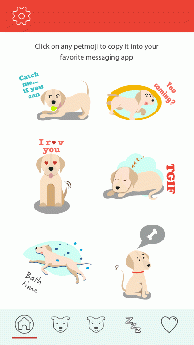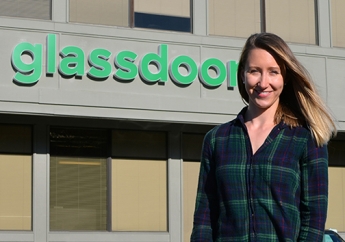We recently had the opportunity to visit Extension student and product specialist Lisa Jacquiot. During our conversation, she talked about her background, her educational goals and what she hopes to achieve with her studies in the Professional Program in User Experience (UX) Design.
Starting With a Business Background
Born and raised in France, Lisa came to the United States to study, graduating from the University of San Francisco with a degree in finance. After graduation, Lisa joined Glassdoor, a company-rating site. Today, she oversees product launches in francophone markets, including product localization, QA testing and reporting. She also handles all French customer care, content moderation and blogging, and manages Glassdoor's French social media platforms.
Lisa's No.1 Advice for Succeeding in the UX Design Program: "Start by taking the UX design and visual design classes. These will give you the skills and knowledge you need to successfully complete the other classes."
The Old Desire to Design Resurfaces

While participating in engineering hacks at Glassdoor, her interest in user experience design was piqued. During her adolescence in France, Lisa had an online shop and designed banners for a variety of customers. Design, however, didn't seem like a viable career, so when it came to an educational path, she picked business administration. That nascent design interest matured as she solved more and more work challenges that needed fresh ideas for getting the right information and experiences to users.
In a meeting with her mentor at work, she searched for "UX programs," and Extension appeared atop the search listings. Lisa acted immediately on that information. "It just so happened that an information session was going to be that night, two hours after my meeting. So, I left and went!"
Putting New Skills to Work
Having almost completed the program, Lisa picks out Diagramming and Prototyping as her favorite class. She appreciates that instructor Ashley Pfahler brought in working professionals to discuss the real-world applications of their lessons. Lisa was working on an app for a class project, a bitmoji for pets, and got constructive feedback and advice to improve it. "It was great to see that I had made enough progress in UX to create delightful experiences, even from another designer's perspective," Lisa shares.
From the beginning of her classroom experiences, Lisa has been applying what she has learned in her job. "I started working on projects for Glassdoor just one semester into the program. I’ve become an unofficial UX designer there—I am trusted with projects and some complex UX problems. For example, I’ve redesigned the help center, worked on a new way for users to flag reviews and am currently working on a new feature on company profiles."
Lisa applied for one of our 2018 scholarships, and was one of the lucky four to receive tuition support up to $1,000.
Lisa's Advice No. 2 for Succeeding in the UX Design Program: "Advocate for yourself within your company–it’s really important to tell your team, your manager and the rest of the company what you are learning. Also tell them that you want to do more UX design. No one will help you to become a designer or take on projects if you don’t express your desire to do that."
A Future of Delighting Users

Lisa is already looking toward the future of UX. She knows that technology is always changing, and that new systems are being developed. A wide range of digital assistants such as Siri, Alexa and Google Home now integrate speech. Lisa knows that these and the technologies of the future are going to demand more from design. "In these cases," Lisa says, "UX design isn’t just about presenting compelling information and making that information easy to navigate, as on a traditional website, but also for creating interfaces where interactions are unscripted, and creating new mental models for interactions."
Lisa's Advice No. 3 for Succeeding in the UX Design Program: "It’s important to have a routine throughout the semester. Going to class twice a week for three hours after work, and putting in 12 hours of homework per week can be hard when you have a full-time job and need a little bit of a social life. Be organized (set homework times) and keep a good routine (set exercise/relaxing times and go to bed early).
It was clear to see why Lisa Jacquiot is impressing her instructors and her employers. She has taken an interest, immersed herself in its study and then found ways to apply that newfound knowledge to her career.



